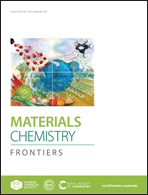The dual effect of “inorganic fullerene” {Mo132} doped with SnO2 for efficient perovskite-based photodetectors†
Abstract
The electron transport layer (ETL) transfers the photogenerated electrons generated by the perovskite layer to the conductive glass substrate, which plays a vital role in the performance of the perovskite-based photodetector. SnO2, as a wide bandgap semiconductor, is a promising ETL material, but the interface electronic recombination between it and the perovskite layer limits the improvement of device efficiency. It is hopeful that {Mo132} will solve this problem. Here, we doped SnO2 with {Mo132}, which can simultaneously adjust the energy level of SnO2 and increase the crystallinity of the perovskite crystal, thereby reducing interface electronic recombination. The conduction band of the obtained composite material moves down by 0.11 V, which is more conducive to the transfer of photogenerated carriers. Moreover, the doping of {Mo132} significantly increases the ultraviolet light absorption intensity of the composite material, which is conducive to the collection of sunlight. In addition, the oxygen vacancy content of the composite material is reduced, which is conducive to reducing the electron recombination center. Therefore, the photocurrent of the device is increased from 13.32 μA to 27.04 μA, an increase of about 1.03 times.



 Please wait while we load your content...
Please wait while we load your content...